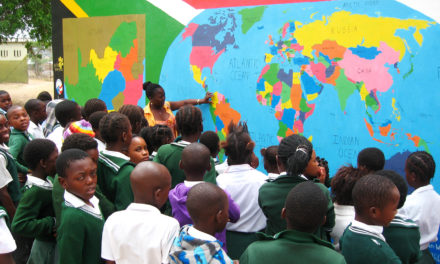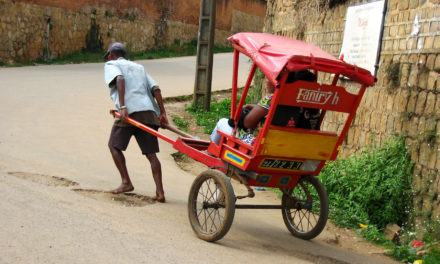E ven Madagascar’s biggest cities are relatively undeveloped, with traditional markets being the main source of food, few paved roads, and most homes without indoor plumbing. But we went a long ways even from that. Our team took a vehicle as far out as the dirt road would take us. Then, after about five hours of walking over mountains, through jungles, and crossing rivers, we arrived in Antenina. Though the largest village in the area, Antenina is still filled with thatched huts, bamboo fences, and an agricultural subsistence lifestyle. There’s no electricity, no cell phone signal, no running water, not even a single water well.
For our team, a group of 6 Malagasy and 4 foreigners (including the 3 of us), a generous person in the village gave us the use of two of their huts. Like most people in the village, we slept on the floor, cooked our rice over a fire, gathered water from the river as well as bathed and washed our clothes there too, and used candles to see at night. We also spent time working with the villagers in their rice fields, went to the jungle to gather wood for fire or construction, and generally did our best to learn about many of the aspects of their lifestyles while also beginning relationships with the people there.
The truth is, life in Antenina hasn’t changed a whole lot for a LONG time. A large mortar and pestle is still in everyday use for every household. Grass mats are used to dry rice or coffee beans or berries in the sun. Chickens and ducks roam freely throughout the village and pigs and cows make their daily transits. Most houses are constructed the same way they always have been for over a thousand years – not even using any nails, but instead tying beams together with natural raffia string or driving wooden stakes through the cross-beams of larger structures. Work in the rice fields is mostly done bent over and by hand, with only the simplest metal hoe used to prepare the ground. Children’s toys are whatever the kids can fashion from pieces of bamboo and raffia string. Because of all this, Lora said it was “like living in an archaeology museum!”
Even after our years with Peace Corps in rural South Africa, adapting to the even more traditional Malagasy lifestyle in Antenina wasn’t always easy for us. The first day we were invited to help a neighbor in their rice fields, I wore my simple sandals for the walk out there. I wasn’t prepared for the coming rain, for the mud and slippery paths, and the complete worthlessness of my sandals both for staying attached to my feet in the sticky mud and for keeping me from slipping down the hillsides. I had no choice but to try what worked best for the villagers: barefoot the whole way! Nor did I realize how far our neighbor’s rice fields were from the village. So, I wound up walking several miles barefoot through mud, creeks, jungles, and mountains. Thankfully it was a well-travelled path and there were no rocks sharp enough to cut my unaccustomed feet. And all that just to arrive at a rice field and spend most the day bent over in muddy water up to my knees while plucking young rice seedlings for transplant!
T hough life in rural Madagascar is so traditional and old, even there things are changing, new things are being introduced. Our first night at the village was a mostly sleepless one, both because of the uneven bamboo floor planks jabbing up in our backs and because of the ridiculously loud thumping music coming from a few hundred feet away. That’s right, even in a village without electricity, they managed to bring in a gas-powered generator and a stack of speakers to celebrate all night long (several nights in a row) for a special occasion.
This particular special occasion is what’s called a “tsaboraha” – a very traditional time for people in the Betsimisaraka tribe to invite their extended family, slaughter a cow, and speak to their dead ancestors while giving them offerings, trying to please them and get their blessing. That’s all followed by a time of celebration, spending several nights dancing and drinking lots of homemade sugar-cane rum. It used to be accompanied by local traveling Malagasy musicians. But with the introduction of gas-powered generators and speakers (that can be carried any distance with a bamboo pole and a few strong guys), the traditional live music has been replaced.
According to the people of Antenina, the “tsaboraha” should take place between June and September, and every family has to perform it at least once every two years. Otherwise, they say, their ancestors will kill a member of their family and they have plenty of stories to prove it. It’s an enormously expensive occasion by rural Malagasy standards, costing upwards of a year’s income for a typical family. But, when the lives of your still-living family members are at stake, you do what you have to do and you do your best at it. So, during our three weeks in Antenina, we spent every weekend hearing the thumping music of a “tsaboraha” all night long.
But even electric music at a “tsaboraha” is more of a novelty than an actual new thing. It’s just a new form replacing an old one, while the deeper reality is unchanged. The old life, the one that lives in fear of unpredictable ancestors’ curses still thrives.
A s Christians, we believe God when he said, “Behold, I am making all things new!” (Rev. 21:5) We have faith that the old crippled life of fear, as well as the culture which drives it, will be made new! We even believe that individuals’ lives, and sometimes whole communities, can be made new now, by the new life of Jesus.
Yet all too often, our “Christian” efforts tend not to be much different than replacing traditional music with high-powered electric stuff – while the underlying core remains the same. This is even more true in historical missions efforts and I’ve seen its evidence everywhere I’ve been.
Pretty much all of Madagascar’s towns and cities (reachable by vehicle) have been “evangelized”. But so often in these places, the “gospel” which was brought has been little more than a different set of rules to live by… hardly any different in character than the lengthy list of “fady” (taboo) which Malagasy people already received from their ancestors. For those locals wishing to make an impression on the wealthy foreigners or visitors who brought this “gospel” to them, they’ll certainly accept or even become church leaders. But the Jesus who’s at the center of the gospel is easily forgotten or misplaced, and the ancestors who used to rule their lives are now simply the co-rulers – along with the set of new Christian rules. Rather than a new or abundant life, this one is even more restrictive and oppressive still.

Along our hike to Antenina we saw this rural church building in the background, with an altar for sacrifices to ancestors in the foreground. Because real new life isn’t often communicated, the church becomes just one more thing to add to traditional religion.
In this situation, because a person’s life itself hasn’t changed, not at the core, there’s no reason to share new life either. You can’t share what you haven’t received. And so Madagascar’s rural locations, for the most part, are still relatively untouched by the Gospel. Mostly, people just don’t want to go there because it’s difficult. Some of the major denominations here have made some rural inroads in the more popular areas of the country, including this area, but often just in attempts to increase their offering intake or their political base. The people actually spreading those churches often don’t realize themselves it’s anything other than an additional set of rules for life, an activity to tack on to Sunday mornings. And it’s certainly a novelty to the villages that receive it, but it’s not new.
I t’s the same with our Christian efforts everywhere. We often spend so much time thinking about the form and how to make it appealing and widely received. We use modern marketing and hype to gain the fleeting attention of a media-saturated audience. Or on the opposite side we think so much about the desired results and what a cleaned-up Christian should look like. We talk about how much a person needs to read their Bible and pray every day, or the one way to identify if a person has been filled with the Holy Spirit, or the specific areas of life that we know God wouldn’t permit any of us to engage in. In all of our various efforts to distribute the final product, we often forget the manufacturer himself. We’re pandering novelties rather than something authentically new.
A Christian witness is charged with spreading one thing only: Jesus himself. We’re to be nothing more than his simple and broken vessels. When we share rules, we spread religion. When we create structures and buildings, we spread architecture. When we market with media hype and slogans, we spread propaganda. Sometimes and in some situations, God works through those things, but more often than not they hinder rather than spread God’s abundant new life. But when we live and display Jesus, the person, we spread new life – the real deal.
Our efforts should be full of sharing about Jesus’s life and what he’s done in our lives. Each of us who truly know Jesus know the new and abundant life that he’s created in us. That’s what we share. And we should be willing to be a friend, a listener, an encourager, and a fellow learner, with anyone else who’s also willing to seek and see the new life that Jesus wants to create in them. The new life of Jesus is at times both incredibly challenging and incredibly comforting. But when we try to strictly define that image and try to construct it in the life of someone else, we’re robbing them of true life and giving them a broken image at best. Jesus is the foundation and he does the construction for each and every person. That’s not our job. Our job is to invite Jesus and to listen to him and to help others do the same in their own lives.
One more great thing about this new life that Jesus brings is that it often erupts beyond the barriers of an individual’s life. The Kingdom of God is something that’s spreading and will one day overtake the world with new life. As Christians, we’re often the vessels for that as well. We have the privilege to listen to God and see in what way he wants to spread his Kingdom next and what that new life can look like, even in a whole community. But just as Jesus spreads himself, so he’s currently spreading his Kingdom. He doesn’t force it on people, only compels them. No one of us is in charge of what God’s Kingdom should look like for a whole area. But we listen to him, we work together as Christians and in our communities, and God spreads his Kingdom where and when it’s welcomed and received with joy!
I n the village of Antenina, we not only saw so much of the old life, and a few of these novelties that the Western world can bring, but we saw real and authentic new life sprout and grow as well! God’s Kingdom is spreading there!

One of our bible studies in Antenina… they often went late into the evening so we continued by candlelight.
As a group, we split up and started many different Bible studies with people and took time to talk about some of the major stories in the Bible and listen to the villagers’ thoughts about the stories. For some of them, even before we spoke about Jesus, the Holy Spirit was already working in their lives and they were begging for more time and more explanation of what “faith” really is. And when they learned that the God of the universe humbled himself to become a man, that we might know him and receive him by faith, they were astonished and amazed. The men invited their wives, and Bible stories every other day wasn’t enough anymore. They started sharing the stories with people around them.
The first person to really latch on, even as we discussed the faith of Abraham, told us how his life was already changing and he wasn’t short-tempered with his wife anymore (though we never even talked about that Christian trait to him at all). Then his wife started joining us herself and was as thirsty for more as her husband was.
Another man in our group was the one who conducted the “tsaboraha” during our second week there and so he missed a couple of the Bible studies. When the “tsaboraha” was finished, he said he was just happy it was done. By then we were talking about Jesus and he was amazed that God became a man and a relationship with him was free and not built on rules. He had never felt worthy to speak a prayer to God before, but he prayed that night among us. He told us the next day about how he was in his rice fields and he asked God for strength and God answered by renewing his energy and making him strong. His wife also started coming to our Bible studies and was one who begged for them to happen every day. So we obliged.

In the hole me and Toky dug for our pit toilet behind our house in the village. Obviously we used it, but it’s also supposed to serve as an example for the rest of the village.
In addition to the Bible studies, we were able to introduce another aspect of new life by sharing teachings about sanitation and hygiene that can help prevent the spread of diseases in the village. In rural Madagascar, few people use any sort of toilets, and instead go to the bathroom wherever they want, often spreading disease that way. So we spent days digging and building our own pit toilet as well as others around the village and shared the teaching with neighboring villages as well. We also talked about malaria prevention and how to purify drinking water. YWAM Tamatave has already started a rural clinic in Antenina and so our teachings and examples were just a supplement to what’s already been started there. We believe God’s abundant life includes healthier lives as well and so we were privileged to spread a small part of that in Antenina.
God is working! Even where old life has been barely changed for thousands of years, new life is breaking in and beginning! The community of Antenina hasn’t been transformed yet, but the seeds of that transformation have been planted. We’ll be back again in three weeks and have a chance to see them watered little bit more. But all this writing is as much for me as for you. Pray for us that we’d always remember the one thing we’re bringing: Jesus. Pray that we’d only ever bring new life and not simply novelty.
We eagerly await this promise: “Behold, I’m making all things new!”
In Christ,
Adam, Lora, and Matimu
P.S. We just have a few recent pictures in this post for now, but we have a couple photo albums worth that I want to upload to our photo page when we get a chance. Our last photo album was from central Madagascar and much is different here on the coast! I’ll send a link once our other pictures are online.

A panorama taking from the mountain above the village of Antenina, where we stayed the last 3 weeks. You have to look a bit close, but you can see the village there in the middle, nestled between the mountains and forests and the river.








